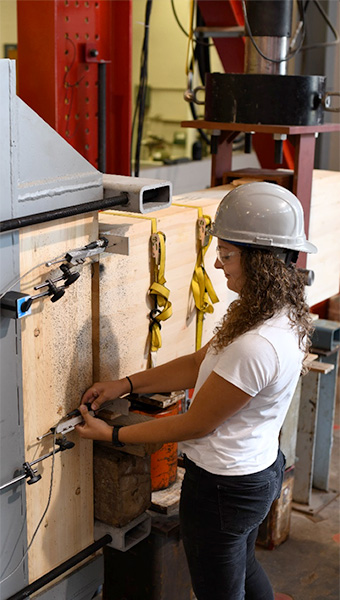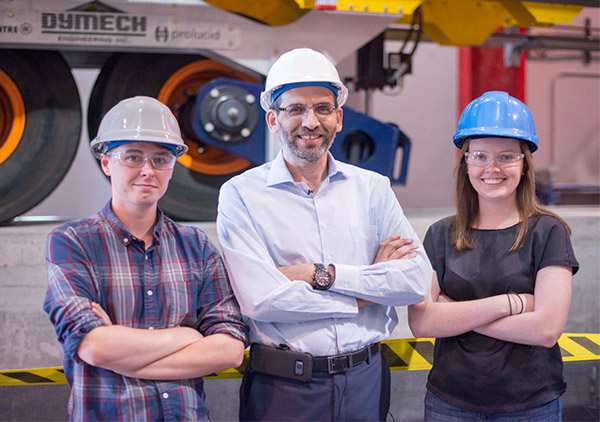The Structures Group in the Department of Civil Engineering focuses on research in the areas of novel and sustainable materials and systems for new construction and the retrofitting of existing structures. The performance of structures under extreme low and high temperatures and in fires, are other areas of focus.
Research on novel materials and systems includes applications of Fibre Reinforced Polymer (FRP) reinforcements in new buildings and bridges, as well as the use of high-performance materials and structural systems for seismic resilience. Group members are international leaders in stay-in-place structural formwork for concrete construction, as well as the repair and strengthening of existing structures using externally bonded sheets and plates, including a pioneered prestressed system. Their research on novel and sustainable materials also includes insulated concrete sandwich panels made of Ultra-High Performance Concrete (UHPC) (see Figure 1) and straw bale construction for energy efficient buildings, recycled aggregate concrete, timber structures with novel connections (see Figure 1), and bio-based FRPs with natural fibres (e.g., flax) and bioresins.

The group is a Canadian leader and has been internationally recognized in the area of FRP-reinforced structures under extreme temperatures, and has collaborated closely with the National Research Council of Canada (NRC) to better understand the performance of concrete structures in fires.
Other research focuses on the Structural Health Monitoring (SHM) of structures using fibre optic sensors and digital image correlation. This is leading to new methods for estimating stresses and deflections in buildings, bridges, and buried pipes. Additional research focuses on large-scale experimental testing and the development of advance test methods (e.g. hybrid simulation) for full-scale civil structures.
The structures laboratory is equipped with state-of-the-art testing facilities, including the only Rolling Load Simulator (ROLLS) for testing highway bridges in Canada (see Figures 2 and 3) and large-scale environmental chambers. The ROLLS is able to simulate heavy truck cyclic loading up to 250 kilonewtons on a bridge, with the simulator’s two full-size dual tires moving at speeds of up to 6 metres per second. This enables world-class research on the fatigue of bridges to be conducted with a new level of realism. The group conducts many of these research projects in collaboration with industrial and government partners, including the Ministry of Transportation of Ontario (MTO), the Canadian Precast/ Prestressed Concrete Institute (CPCI), and Bombardier Transportation.
The group is one of the strongest structures teams in Canada. Within their ranks are two former Canada Research Chairs, and an editor and associate editors of journals that include the Canadian Journal of Civil Engineering and the American Society of Civil Engineers’ (ASCE) Journal of Composites for Construction. The group has fellows of various societies, such as the Canadian Society for Civil Engineering (CSCE), the Canadian Academy of Engineering (CAE), the Engineering Institute of Canada (EIC), the American Concrete Institute (ACI), and the ASCE. The group has also received a number of major grants, including a $3.5 million Canada Foundation for Innovation (CFI) grant, which led to the development of the ROLLS; a Natural Sciences and Engineering Research Council of Canada (NSERC) Collaborative Research and Training Experience (CREATE) grant for Sustainable Engineering in Remote Areas (SERA); and two Ontario Early Researcher Awards (ERAs).



Researchers in this group: